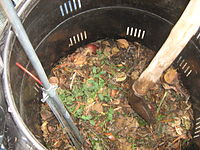 The District of Muskoka undertakes the waste management for all the communities in Muskoka including here in Bracebridge. There are extensive recycling programs that reflect the mindset of our beautiful area. We love the beauty and pristine nature of Muskoka and we want to keep it that way.
The District of Muskoka undertakes the waste management for all the communities in Muskoka including here in Bracebridge. There are extensive recycling programs that reflect the mindset of our beautiful area. We love the beauty and pristine nature of Muskoka and we want to keep it that way.
In the urban areas within the district there is a green box program for organic waste. The district collects this waste and turns it into compost which is then offered back to the residents in the spring just in time for putting into their gardens.
Compost is a fantastic way to recycle. If you are outside of the urban areas that have this District service or not currently a Muskoka resident, here are some “how to” tips for making your own compost. Nature creates compost all the time without human intervention. You can simply put you organic waste into an animal proof container and leave it to decompose nature’s way. But as a homeowner you can step in and speed up the composting process by creating the optimal conditions for decomposition: Air + Water + Carbon + Nitrogen = Compost
Air – Like most living things, the bacteria that decompose organic matter and the other creatures that make up the compost ecosystem, need air. Compost scientists say compost piles need porosity—the ability for air to move into the pile. You can think of porosity in terms of fluffiness. A fluffy pile has plenty of spaces—or pores—for air to move about. A flat, matted pile of, say, grass clippings does not. Even fluffy piles compress during the composting process. Occasionally turning your pile re-fluffs the material, moves new material into the center, and helps improve air flow into the pile.
Water – Compost microbes also need the right amount of water. Too much moisture reduces airflow, causes temperatures to fall, and can make the pile smell. Too little water slows decomposition and prevents the pile from heating. Conventional wisdom says that compost should feel like a wrung-out sponge.
Carbon Ingredients – The microbes that break down organic matter use carbon as an energy source. Ingredients with a high percentage of carbon are usually dry and brown or yellow in color. The most common high-carbon ingredients are leaves, straw, and corn stalks. Sometimes people call these ingredients browns.
Nitrogen Ingredients – Microbes need nitrogen for the proteins that build their tiny bodies. Ingredients high in nitrogen are generally green, moist plant matter, such as leaves, or an animal by-product, such as manure. These ingredients are called greens, but in reality they can be green, brown, and all colors in between.
C/N Ratio – In order for a compost pile to decompose efficiently, you need to create the right ratio of carbon (C) to nitrogen (N) (C/N). Piles with too much nitrogen tend to smell, because the excess nitrogen converts into an ammonia gas. Carbon-rich piles break down slowly because there’s not enough nitrogen for the microbe population to expand. An ideal compost pile should have a 30:1 C/N ratio. Grass clippings alone have about a 20:1 C/N ratio. Adding one part grass clippings, or other green, to two parts dead leaves, or other brown, will give you the right mix.
The District of Muskoka provides a list of items that can be put into urban compost which includes more of the nitrogen rich components than you should use in a home system but not the garden waste, however with your garden waste mixed in with your kitchen waste you should be able to create an awesome compost pile.
Remember in Muskoka, the amount of curbside waste you can put out for weekly pick-up is limited so using the recycling program makes it easy to comply. Without recycling you will likely find it difficult to avoid creating too much garbage. Reduce, reuse and recycle to keep Muskoka beautiful!